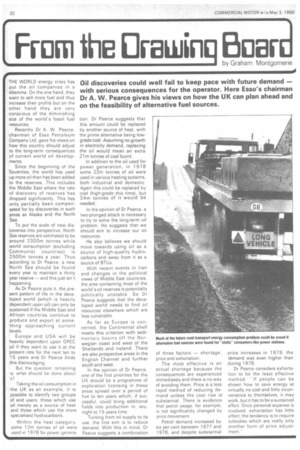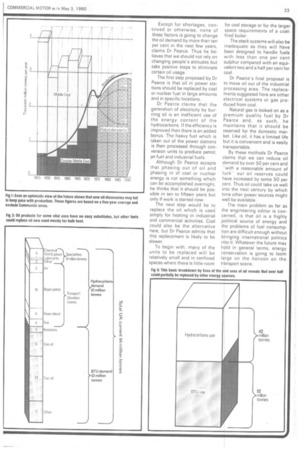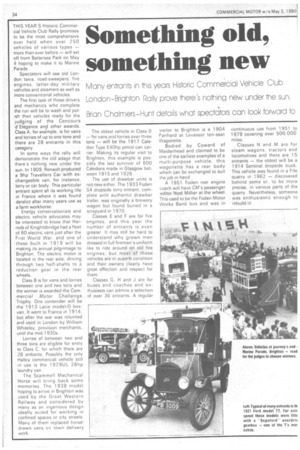( From the Orakiiinq Boar
Page 34

Page 35

Page 36

If you've noticed an error in this article please click here to report it so we can fix it.
by Graham Montgomere Oil discoveries could well fail to keep pace with future demand — with serious consequences for the operator. Here Esso's chairman Dr A. W. Pearce gives his views on how the UK can plan ahead and on the feasibility of alternative fuel sources.
THE WORLD energy crisis has put the oil companies in a dilemma. On the one hand, they want to sell more fuel and thus increase their profits but on the other hand they are very conscious of the diminishing size of the world's fossil fuel resources.
Recently Dr A. W. Pearce, chairman of Esso Petroleum Company Ltd, gave his views on how this country should adjust to the long-term consequences of current world oil developments.
Since the beginning of the .Seventies, the world has used up more oil than has been added to the reserves. This includes the Middle East where the rate of discovery of reserves has dropped significantly. This has only partially been compensated for by discoveries in such .areas as Alaska and the North Sea.
To put the scale of new discoveries into perspective, North Sea reserves are estimated to be around 2300m tonnes while world consumption (excluding Communist countries) is 2500m tonnes a year. Thus according to Dr Pearce, a new North Sea should be found every year to maintain a thirty year reserve — and this just isn't happening.
As Dr Pearce puts it, the present pattern of life in the developed world (which is heavily dependent upon oil) can only be sustained if the Middle East and African countries continue to produce and export at something approaching current levels.
Europe and USA will be heavily dependent upon OPEC oil if they want to use it at the present rate for the next ten to 15 years and Dr Pearce .finds this discouraging.
But the question remaining is: what should be done about it?
Taking the oil consumption in the UK as an example, it is possible to identify two groups of end users: those which use oil merely as a source of heat and those which use the more specialised hydrocarbons.
Within the heat category, some 12m tonnes of oil were used in 1978 for power genera tion. Dr Pearce suggests that this amount could be replaced by another source of heat, with the prime alternative being lowgrade coal. Assuming no growth in electricity demand, replacing the oil would mean an extra 21m tonnes of coal burnt.
In addition to the oil used for power generation, in 1978 some 22m tonnes of oil were
used in various heating systems, both industrial and domestic. Again this could be replaced by coal (high-grade this time), but .34m tonnes of it would be needed.
In the opinion of Dr Pearce, a two-pronged attack is necessary to try to solve the long-term oil problem. He suggests that we should aim to increase our oil resources.
He also believes we should move towards using oil as a source of high-quality hydrocarbons and away from it as a source of BTUs.
With recent events in Iran and changes in the political views of Middle East countries, the area containing most of the world's oil reserves is potentially politically unstable. So Dr Pearce suggests that the developed world needs to find oil resources elsewhere which are less vulnerable.
As far as Europe is concerned, the Continental shelf meets this criterion with sedimentary basins off the Norwegian coast and west of the Shetlands and Ireland. There are also prospective areas in the English Channel and further south and west.
In the opinion of Dr Pearce, one of the first priorities for the UK should be a programme of exploration licensing in these areas spread over a period of five to ten years which, if successful, could bring additional fields into production in, say, eight to 1 5 years time.
Turning from oil supply to its use, the first aim is to reduce demand. With this in mind, Dr Pearce suggests a combination gimmi■■■■. of three factors — shortage, price and exhortation.
The most effective is an actual shortage because the consequences are experienced immediately and there is no way of avoiding them. Price is a less rapid method of reducing demand unless the cost rise is substantial. There is evidence that petrol usage, for example, is not significantly changed by price movement.
Petrol demand increased by six per cent between 1977 and 1978, and despite substantial price increases in 1979, the demand was even higher than during 1978.
Dr Pearce considers exhortation to be the least affective method.: -If people can be shown how to save energy at virtually no cost and little inconvenience to themselves, it may work, but it has to be a sustained effort. Once personal expense is involved, exhortation has little effect: the tendency is to require subsidies which are really only another form of price adjustment.
Except for shortages, con..trived or otherwise, none of these factors is going to change the oil demand by more than ten per cent in the next few years, claims Dr Pearce. Thus he believes that we should not rely on changing people's attitudes but ,take positive steps to eliminate certain oil usage.
The first step proposed by Dr Pearce is that oil in power stations should be replaced by coal or nuclear fuel in large amounts and in specific locations.
Dr Pearce claims that the generation of electricity by burning oil is an inefficient use of the energy content of the hydrocarbons. If the efficiency is improved then there is an added bonus. The heavy fuel which is taken out of the power stations is then processed through conversion units to produce petrol, jet fuel and industrial fuels.
Although Dr Pearce accepts that phasing out of oil and phasing in of coal or nuclear energy is not something which can be accomplished overnight, he thinks that it should be possible in ten to fifteen years but only if work is started now.
The next step would be to replace the oil which is used simply for heating in industrial and commercial activities. Coal could also be the alternative here, but Dr Pearce admits that this replacement is likely to be slower.
To begin with, many of the units to be replaced will be relatively small and in confined spaces where there is little room for coal storage or for the larger space requirements of a coalfired boiler.
The stack systems will also be inadequate as they will have been designed to handle fuels with less than one per cent sulphur compared with an equivalent two and a half per cent for coal.
Dr Pearce's final proposal is to move oil out of the industrial processing area. The replacements suggested here are either electrical systems or gas produced from coal.
Natural gas is looked on as a premium quality fuel by Dr Pearce and, as such, he maintains that it should be reserved for the domestic market. Like oil, it has a limited life but it is convenient and is easily transportable.
By these methods Dr Pearce claims that we can reduce oil demand by over 50 per cent and "with a reasonable amount of luck" our oil reserves could have increased by some 50 per cent. Thus oil could take us well into the next century by which time other power sources might well be available.
The main problem as far as the engineering editor is concerned, is that oil is a highly .political source of energy and the problems of fuel consumption are difficult enough without bringing international politics ir to it. Whatever the future may hald in general terms, energy conservation is going to loom large on the horizon on the transport scene. THIS YEAR'S Historic Commercial Vehicle Club Rally promises to be the most comprehensive • ever held when over 250 vehicles of various types — more than ever before — will set off from Battersea Park on May 4 hoping to make it to Marine Parade.
Spectators will see old London taxis, road-sweepers, fire engines, latter-day military vehicles and steamers as well as more conventional vehicles.
The first task of those drivers and mechanics who complete the run will be to wash and polish their vehicles ready for the judging of the Concours d'Elegance and other awards. Class A, for example, is for vans and lorries of up to one tone and there are 28 entrants in this category.
In some ways the rally will demonstrate the old adage that there's nothing new under the sun. In 1909, Renault produced a 9hp Travellers Car with exchangeable van, for instance, lorry or car body. This particular entrant spent all its working life in France where it was found derelict after many years use as a farm workhorse.
Energy conservationists and electric vehicle advocates may be interested to know that Harrods of Knightsbridge had a fleet of 60 electric vans just after the First World War, and one of • these built in 1919 will be making its annual pilgrimage to Brighton. The electric motor is located in the rear axle, driving through two half-shafts to a reduction gear in the rear wheels.
Class B is for vans and lorries between one and two tons and the winner is awarded the Commercial Motor Challenge Trophy. One contender will be the 1913 Lacie model-0 boxvan. It went to France in 1914,. but after the war was returned and used in London by William Whiteley, provision merchants, until the mid-1930s.
Lorries of between two and three tons are eligible for entry to Class C, for which there are 28 entrants. Possibly the only Halley commercial vehicle still in use is the 1929UL 26hp laundry van.
The Scammell Mechanical Horse will bring back some memories. The 1938 model hoping to arrive in Brighton was used by the Great Western Railway and considered by many as an ingenious design ideally suited for working in confined spaces or city streets. Many of them replaced horse= drawn vans on town delivery work.












































































































